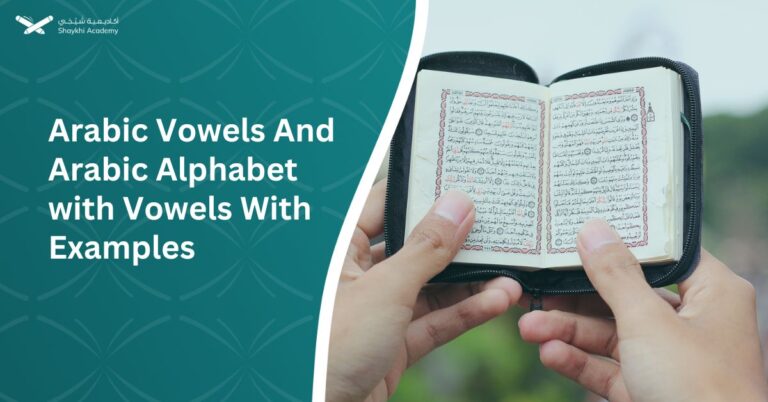The possessive pronouns show the ownership statuses between the owned objects and its owners. This article rummages through the intricacies of the Arabic possessive pronouns to present a deep understanding of their characteristics, usages, and functions inside the Arabic sentence syntax. Keep reading, go no further.
The possessive pronouns are very important in the Arabic sentence formation. Grasping the fundamental grammatical aspects of the possessive pronouns is essential for comprehending the Arabic sentence structure.
Meaning of Possessive Pronouns in Arabic:
An Arabic possessive pronoun works as a suffix that is attached to the end of a noun to modify this noun. A possessive pronoun is used to indicate possession status or to refer to the close relationship between an owned object and its owner.
Determining the appropriate possessive pronoun in an Arabic sentence is basically identified by two factors related to the sentence subject; gender and number. Therefore, the kinds of the possessive pronouns are various, each kind should cope with the owner that it refers to.
Some possessive cases can also refer to relationships, not just items. Check Shaykhi Academy’s Learn Arabic Online Course for more details about this point.
Arabic Possessive Pronouns Chart
Here is a chart of the possessive pronouns in Arabic language with a translation of their English equivalents and a description of their conjugations.
| Arabic Possessive Pronouns | English Equivalents | Conjugation Description |
| ي (Ey) | My | First Person Singular |
| نا (Na) | Our | First Person Plural |
| كَ (Ka) | Your | 2nd Person Singular Masculine |
| كِ (Ki) | Your | 2nd Person Singular Feminine |
| كُمَا (Koma) | Your | 2nd Person Dual Masculine |
| كُمَا (Koma) | Your | 2nd Person Dual Feminine |
| كُم (Kom) | Your | 2nd Person Plural Masculine |
| كُنَّ (Konna) | Your | 2nd Person Plural Feminine |
| هُ (hu) | His | 3rd Person Singular Masculine |
| هَا (ha) | Her | 3rd Person Singular Feminine |
| هُما (Homa) | Their | 3rd person Dual masculine |
| هُما (Homa) | Their | 3rd person Dual Feminine |
| هُم (hom) | Their | 3rd person Plural Masculine |
| هُنَّ (honna) | Their | 3rd person Plural Feminine |
List Of Arabic Possessive Pronouns
In this part, we will introduce all the possessive pronouns with a detailed explanation for each pronoun attached with illustrative examples.
We are going to present the different aspects between each pronoun and the closest pronoun that had some aspect of similarities with it. We will also shed some light on their characteristics, usages and functions. Let’s start.
1. The Arabic Possessive Pronoun (My / ي)
The possessive pronoun [ي / My] is the first pronoun in the possessive pronouns cluster. It is attached as a suffix to the end of an owned object. The noun (the owned object) that is bound up with it should be an indefinite noun, it can be either singular or plural. The function of the possessive pronoun (My /ي) is referring to a first-person singular masculine owner.
Examples of the Arabic Possessive Pronoun (My /ي)
In this section, we will present various examples for the possessive pronoun (my /ي). Pay attention to the description at the end of the timetable.
| English Sentences | Arabic Sentences | Transliteration | Description |
| 1. These are my books. | ١. هَذهِ كُتَبي. | 1. Hadihi kotabe. | The possessive pronoun (My /ي) was attached as a suffix at the end of the owned objects (كتب / سيارة / حبيب) to refer that these objects belong to a first-person singular masculine owner. |
| 2. This man stole my car. | ٢. هَذا الرَجُل سَرَقَ سَيارَتي. | 2. Hadha al-Rajol sa’ra’qa syaratee. | |
| 3. You are my love. | ٣. أنّتَ حَبيبي. | 3. Anta Habibi. |
2. The Arabic Possessive Pronoun (Our / نا)
The possessive pronoun [ نا / Our ] is the second pronoun in the possessive pronouns cluster. It is attached as a suffix to the end of an owned noun. The noun (the owned object) that is bound up with it should be an indefinite noun, it can be either singular or plural. The function of the possessive pronoun (Our / نا) is referring to a first-person plural masculine owner.
Examples of the Arabic Possessive Pronoun (Our / نا / Na)
Here are illustrative examples for the possessive pronoun (our / نا ). Pay attention to the description at the end of the timetable.
| English Sentences | Arabic Sentences | Transliteration | Description |
| A. These are our books. | أ) هَذهِ كُتَبنا | A. Hadihi kotabana. | The possessive pronoun (Our / نا) was attached as a suffix at the end of the owned objects (كتب / مدرسة / خيار) to refer that these objects belong to a first-person plural masculine owner. |
| B. Our school is big. | ب) مَدرسَتُنا كَبيرةٌ. | B. Madrasatona kabeerah. | |
| C. Islam is our choice. | ج) الإسلامُ خِيَارنا. | C. al-Islam kheyrina. |
3. The Arabic possessive Pronouns ( كَ / كِ / Your / Your)
The possessive pronouns ( كَ / كِ / Your / Your) are the third and fourth pronouns in the possessive pronouns cluster. Both of them are attached as a suffix to the end of an owned noun. The noun ( the owned object) that is bound up with any of them should be an indefinite noun, it can be either singular or plural.
The function of the possessive pronoun ( كَ / Your ), “with fat’ha diacritic” is referring to a second person singular masculine owner. Whereas the possessive pronoun ( كِ / Your ), “with kasrah diacritic” is referring to a second person singular feminine owner.
Examples of the Arabic Possessive Pronouns ( كَ / كِ / Your / Your)
Here are illustrative examples for the possessive pronoun ( كَ / كِ / Your / Your). Pay attention to the description at the end of the timetable.
| English Sentences | Arabic Sentence | Transliteration | Description |
| A. Ali, this is your book. | أ) عَلي، هَذا كِتابكَ. | A. Ali, Hadha kitabak. | ● The possessive pronoun ( كَ / Your), “with fat’ha diacritic” was attached as a suffix to the end of the owned objects (كتاب / إسم) to refer that these objects belong to a second person singular masculine owner.● Whereas the possessive pronoun ( كِ / Your), “with kasrah diacritic” was attached as a suffix to the end of the owned objects (كتاب / اسم) to refer that these objects belong to a second person singular feminine owner. |
| B. Mona, this is your book. | ب) مُنى، هَذا كِتابكِ. | B. Mona, Hadha kitabake. | |
| C. Hey boy, what is your name? | ج) مَا اسْمكَ، يا وَلد؟ | C. Ma esmak ya walad? | |
| D. Hey girl, what is your name? | د) مَا اسْمكِ، يا بْنت؟ | D. Ma esmake ya bent? |
4. The Arabic Possessive Pronouns (كُما / كُما / كُم / كُنّ Your / Your / Your/ Your)
The possessive pronouns ( كُما / كُما / Your / Your) have the same meaning, usages and the same function. They are both absolutely identical. They are attached as a suffix to the end of an owned noun. The noun (the owned object) that is bound up with any of them should be an indefinite noun, it can be either singular or plural. They are used to refer to a second person dual masculine or feminine owner.
The function of the possessive pronouns ( كُم / Your) is referring to a second person plural masculine owner. Whereas the possessive pronoun ( كُن / Your ) is referring to a second person plural feminine owner.
Examples of the Arabic Possessive Pronouns (كُما / كُما / كُم / كُنّ Your / Your / Your/ Your)
Here are illustrative examples for the possessive pronoun (كُما / كُما / كُم / كُنّ Your / Your / Your/ Your). Pay attention to the description at the end of the timetable.
| English Sentences | Arabic Sentences | Transliteration | Example Description |
| A. Mona! Heba! Listen. This is your room. | أ) مُنى، هْبه! هَذه حُجرَتكُما. | A. Mona, Heba, Hadhihi hogratakoma. | In example 1, the possessive pronoun ( كُما / Your) was attached as a suffix to the noun ( حجرة / room) to refer that it belongs to Heba and mona who are second person dual feminine owner. |
| B. Ali! Hassan! This is your school. | ب) عَلْى، حَسْن! هَذه مَدرَسَتكُما. | B. Ali, Hassan! Hadihi madrasatikoma. | In example 2, the possessive pronoun ( كُما / Your) was attached as a suffix to the noun ( مدرسة /school) to refer that it belongs to Ali and hassan who are second person dual masculine owner. |
| C. Hey guys, this is your classroom. | ج) يا شَبْاب، هَذا فَصلَكُم. | C. Ya shabab, Hadha faslokom. | ● In example 3, The possessive pronoun ( كُم / Your) was attached as a suffix to the noun ( فصل / classroom) to refer that it belongs to a group of young people who are second person plural masculine owner. |
| D. Hey girl, this is your house. | د) يَا فَتيْات، هَذا مَنْزلَكٌن. | D. Ya, fatayat Hadha manzlokon. | In example 4, the possessive pronoun ( كُن / Your) was attached as a suffix to the noun ( منزل / house) to refer that it belongs to a group of girls who are second person plural feminine owner. |
5. The Arabic possessive Pronouns (ها / ه / His / Her)
The possessive pronouns (ه / his) is attached as a suffix to the end of an owned noun. The noun (the owned object) that is bound up with it should be an indefinite noun, it can be either singular or plural.
The function of the possessive pronoun (ه / his) is referring to a third person singular masculine owner. Whereas the possessive pronoun (ها / her) is referring to a third person singular feminine owner.
Examples of the Arabic Possessive Pronouns (ها / ه / His / Her)
Here are illustrative examples for the possessive pronoun (ها / ه / His / Her). Pay attention to the description at the end of the timetable.
| English Sentences | Arabic Sentences | Transliteration | Description |
| A. This is his book. | أ) هَذْا الكِتاب كِتْابهُ. | A. Hadha el-Kitab kitabaho. | ● In examples numbers (1) (2)The possessive pronoun (ه / his) was attached as a suffix to the end of the owned objects (كتاب /والد) to refer that these objects belong to a third person singular masculine owner.● Whereas the possessive pronoun ( ها/ her), was attached as a suffix to the end of the owned objects ( book / dress /كتاب /فستان) to refer that these objects belong to a third person singular feminine owner. |
| B. Is this man his father? | ب) هَلْ هذا الرَجُل وَالدهُ؟ | B. Hal hadha el-Rajol walidaho? | |
| C. This is her book. | ج) هَذا الكِتاب كِتابَها. | C. Hadha el- Kitab kitabaha. | |
| D. Is this her dress? | د) هَلْ هَذا فُستَانَها؟ | D. Hal hadha fostanaha? |
6. The Arabic possessive Pronouns ( هُما / هُما/ هُم/ هُنّ/ They / They / They/ They)
The possessive pronouns (هُما / هُما / They / They) have the same meaning, usages and the same function. They are both absolutely identical. They are attached as a suffix to the end of an owned noun. The owned object that is bound up with any of them should be an indefinite noun, it can be either singular or plural. They are used to refer to a third person dual masculine or feminine owner.
Whereas the possessive pronoun ( هم / هن / their / their) are attached as a suffix to the end of an owned noun. The owned object which is bound up with any of them should be an indefinite noun, it can be either singular or plural. The possessive pronoun (هم / their) is referring to a third person plural masculine owner, whereas, the possessive pronoun ( هن / their) is referring to a third person plural feminine owner.
Examples of the Arabic Possessive Pronoun ( هُما / هُما/ هُم/ هُنّ/ They / They / They/ They)
Here are illustrative examples for the possessive pronoun هُما / هُما/ هُم/ هُنّ/ They / They / They/ They). Pay attention to the description at the end of the timetable.
| English Sentences | Arabic Sentences | Transliteration | Description |
| A. Ahamad and Ali forgot to bring their books. | أ) نَسْيَ عَلىٌ وأحمدٌ أنّ يَحضْرا كُتِبَهُما. | A. Nasayah Ali wa Ahmad an yahdirah kotabahoma. | ● In example A, the possessive pronoun ( هُما / their) was attached as a suffix to the noun ( كتب / books) to refer that they belong to Ahamad and Ali who are third person dual masculine owner. |
| B. Mona and Heba did not eat their meals. | ب) لَمْ تَأكْل مُنى وهِبه وَجْبَاتَهُما. | B. Lam taekol Mona wa Heba wagbatahoma. | ● In example B, the possessive pronoun ( هُما / their) was attached as a suffix to the noun ( وجبات / meals) to refer that it belong to Mona and Heba who are third person dual feminine owner. |
| C. The guys loved their teacher. | ج) أحْبَ الأْولادُ مُعلِمَهُم. | C. Ahaba al-Awlado mo3lemahom. | ● In example C, The possessive pronoun ( هُم / their) was attached as a suffix to the noun ( معلم / teacher) to refer that it belongs to a group of boys who are third person plural masculine owners. |
| D. The girls helped their mother. | د) سَاعَدتْ البْناَتُ والِدَتهُن. | D. Sa3adit al-Banato waledat’hon. | ● In example D, the possessive pronoun ( هُن / their) was attached as a suffix to the noun (والدة / mother) to refer to a group of girls who are third person plural feminine owners. |
Start Your Journey of Learning Arabic Pronouns with Shaykhi Academy
Shaykhi Academy presents large sets of enhanced theories about the affluence and abundance of the Arabic language grammar.
Shaykhi Academy’s Online Fusha Arabic Course to Learn Modern Standard Arabic is an outstanding course that covers many essential language syntaxes and semantics about all kinds of the Arabic possessive pronouns. It also presents additional grammatical thoughts and points of view.
Shaykhi Academy’s Online Fusha Arabic Course To Learn Modern Standard Arabic is taught under the auspices of the experienced tutors Dr. Mahmoud AlAssal and Sh. Luqman ElKasabany.
All the teaching staff of Shaykhi Academy graduated from Al-azhr Ash-sharif University. They had rich experiences in the Arabic language teaching field. It is essentially to be taught under the aegis of such quality.
Why Shaykhi Academy?
- Expert Native Tutors: Learn from highly qualified native Arabic speakers.
- Flexible Scheduling: Tailor your classes to fit your busy life.
- Affordable Learning: Access top-quality education at a price that suits you.
- Global Access: Study from anywhere in the world.
Explore Our Arabic Courses:
- Noorani Qaida: Build a strong foundation in Quranic Arabic.
- Comprehensive Arabic Courses: Master the Arabic language, from beginner to advanced levels.
- Fusha Arabic Classes: Delve into Modern Standard Arabic, the key to understanding literature, media, and formal communication across the Arab world.
- Quranic Arabic Course: Enhance your connection with the Quran by learning the language in which it was revealed.
Start Your Arabic Journey Today! Whether you’re just starting or looking to deepen your knowledge, Shaykhi Academy is here to support your journey. Book your free trial now and begin your path to Arabic mastery!

Conclusion
An excellent acquisition about the possessive pronouns is an essential demand for the learners towards obtaining Arabic language accuracy. This will definitely prepare the Arabic language’s learners to have a good command of the essentials of the Arabic language’s syntaxes and semantics.














































